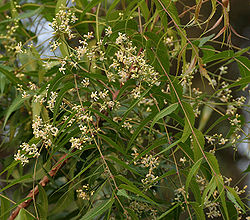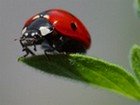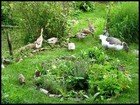What is Neem? A Natural and Organic Pesticide for Insect Control and Recipes
What is Neem?
Neem is a wonderful plant that some of you may or may not have heard of. However, neem has been around for thousands of years, and is well-known in India and South–East Asia where it grows and has been used for many uses, including a way to control insects naturally. Neem seeds, neem oil and even the neem leaves can all be used and have many benefits.Neem today is finally gaining recognition as an organic answer to controlling insects from locust invasions in Africa to leaf miner insects that invade and destroy birch trees in the USA.
What Insects can Neem Control?
Neem can control over 200 insects. Crop insects that have been successfully controlled by neem are:- aphids
- gypsy moths
- leaf miners
- loopers
- mealy bugs
- thrips
- whiteflies
- Colorado potato beetles
- flea beetles
- corn earworms
- cucumber beetles
- Mexican bean beetles
- Caterpillars
Neem is a highly
effective pesticide that once sprayed, will keep the
insects at bay. It works in a variety of ways
from killing all
sucking and chewing insects, keeping insects at bay who refuse to eat
the sprayed foliage and end up dying of starvation, as well as
disrupting the sexual reproduction of insects so that their life cycle
is both disrupted and ended.
Best, of all, neem is perfectly safe to spray on vegetables and fruit crops as well as ornamental shrubs and plants. It has also been included in India in toothpaste, soap, shampoo for nits, cosmetics and cattle feed.
However, if neem seeds are consumed directly, these are highly toxic. But neem is harmless to other beneficial insects like birds, bees and ladybirds. Because neem is not toxic to humans and other animals, areas that are sprayed with neem are not areas to be avoided like other areas that are sprayed with synthetic pesticides.
The only organisms affected by neem are those that are chewing or sucking at your plants. Neem is a totally natural product that is biodegradable. And if you are wondering about your earthworms, it was found that in areas where neem was sprayed the population of earthworms increased, as did the size of them.
In addition, bees that were exposed to neem produced 3 times as much pollen and twice as much honey as non-treated bees. (Liu et al, 1989). They also showed a better resistance to mites and other diseases.
This is not surprising when you learn that neem is also used by the Indians to cure medical conditions; psoriasis, athlete’s foot, warts, dandruff, cracked heels, and other medical ailments.
Neem can also be used safely by humans as a natural mosquito repellant. If you live in a mosquito-infested area, this is really good news, as the alternatives out there in using DEET or AREOGUARD is really not a healthy option.
Neem is also good for sand flies and ticks. One application should be good for up to 12 hours. Livestock, if sprayed with neem oil will be given the same level of protection against biting flies, ticks and mosquitoes.
When a concentration of neem seed extract was given to livestock as part of their diet, the horn fly was practically eradicated (Miller and Chamberlain, 1989).
A light coating of neem oil protects stored food crops for up to 20 months from all sorts of infestations with no deterioration or loss of palatability (Dunkle et al, 1995).
Best, of all, neem is perfectly safe to spray on vegetables and fruit crops as well as ornamental shrubs and plants. It has also been included in India in toothpaste, soap, shampoo for nits, cosmetics and cattle feed.
However, if neem seeds are consumed directly, these are highly toxic. But neem is harmless to other beneficial insects like birds, bees and ladybirds. Because neem is not toxic to humans and other animals, areas that are sprayed with neem are not areas to be avoided like other areas that are sprayed with synthetic pesticides.
The only organisms affected by neem are those that are chewing or sucking at your plants. Neem is a totally natural product that is biodegradable. And if you are wondering about your earthworms, it was found that in areas where neem was sprayed the population of earthworms increased, as did the size of them.
In addition, bees that were exposed to neem produced 3 times as much pollen and twice as much honey as non-treated bees. (Liu et al, 1989). They also showed a better resistance to mites and other diseases.
This is not surprising when you learn that neem is also used by the Indians to cure medical conditions; psoriasis, athlete’s foot, warts, dandruff, cracked heels, and other medical ailments.
Neem can also be used safely by humans as a natural mosquito repellant. If you live in a mosquito-infested area, this is really good news, as the alternatives out there in using DEET or AREOGUARD is really not a healthy option.
Neem is also good for sand flies and ticks. One application should be good for up to 12 hours. Livestock, if sprayed with neem oil will be given the same level of protection against biting flies, ticks and mosquitoes.
When a concentration of neem seed extract was given to livestock as part of their diet, the horn fly was practically eradicated (Miller and Chamberlain, 1989).
A light coating of neem oil protects stored food crops for up to 20 months from all sorts of infestations with no deterioration or loss of palatability (Dunkle et al, 1995).
Traditional Uses of Neem in Farming
Traditionally, Neem has
been used by farmers for a variety of problems and they have used the
bark, the leaves, the neem oil extracted from the neem seeds, as well
as the residual material left over from the seed pressings called a
neem cake.
- The neem cakes, leaves and twigs are turned into the ground to be used as a soil enhancer, mulch and to control soil pests, particularly nematodes, and soil pests that chew the roots and stems of growing plants.
- Jute bags are treated with neem oil before stored with grains to protect the grain against insects. The grain is also mixed with neem leaves as an added precaution.
- A neem tea is made from the neem seeds by crushing them, steeping them in water overnight and then spraying the solution directly onto the crops. This sort of application will protect the crops for a week, but then will need to be reapplied for total protection.
- The neem wood, although part of the Mahogany family, doesn't really polish up well but is still used traditionally for furniture as the wood is not affected by wood-boring insects. Neem wood is particularly useful in poles for fencing as it is not attacked by termites.
Applying Neem to your Crops, Fruit and Vegetables
 When using neem as in
insect-repellant on your
plants it quickly breaks
down due to the sunlight over 5-7 days, and therefore should be applied regularly to
be
effective.
When using neem as in
insect-repellant on your
plants it quickly breaks
down due to the sunlight over 5-7 days, and therefore should be applied regularly to
be
effective. However, one thing to take into consideration is that insects do not become immune to neem spray like other insecticides. Therefore each application makes it just as effective as the last application.
However, be patient when applying your neem. Once you make your first spray, don’t expect the insects to drop dead on the spot. They will remain on your plants for at least 2 weeks.
Neem as a natural insecticide
However, just because the insects are present doesn’t mean that they are doing any further harm – they are not. They have definitely been affected.
Using Neem Seeds in Homemade Neem Recipes
For small areas, and if
you have access to neem seeds you can make your
own homemade neem recipe.
Take 1 ounce (25 grams) ground neem seeds and place in a bucket. Pour over 2 cups (500 ml) of luke wam water. Mix well and let it steep for up to 4 hours. Filter the mixture through an old nylon stocking to get rid of any bits, and then use this on your plants immediately. Spray and repeat the application every 10 days.
Take 1 ounce (25 grams) ground neem seeds and place in a bucket. Pour over 2 cups (500 ml) of luke wam water. Mix well and let it steep for up to 4 hours. Filter the mixture through an old nylon stocking to get rid of any bits, and then use this on your plants immediately. Spray and repeat the application every 10 days.
Here is another Homemade Neem Recipe Using Seeds on a Larger Scale:
Collect neem
seeds depulp and clean. Dry the seeds in the shade for 3-7
days. Discard any that are mouldy. Once dry finely crush in a
mortar or a mill. Mix 1 lb. (500 g) crushed neem seeds with 2.6 gallons
(10 liters) water and leave to sit overnight. The next day filter the
mixture through a piece of fine cloth such as cheesecloth. What is left
can be sprayed directly onto your crops, fruit trees and vegetables.
Apply only once a week and repeat every 10 days for good pest control.
Store any unused neem tea in an air-tight container in a cool, dark place.
For larger areas buy a commercially prepared neem spray. There are several around now that can be purchased off the Internet.
Apply only once a week and repeat every 10 days for good pest control.
Store any unused neem tea in an air-tight container in a cool, dark place.
For larger areas buy a commercially prepared neem spray. There are several around now that can be purchased off the Internet.
Leave a Comment
Do you have anything that you would like to add after reading this page? We would love to hear your thoughts. If you can add additional information to what has been written here you will be adding value to the website! No need to have any special skills - just type and submit. We will do the rest!
Other Comments
Click below to see comments from other visitors to this page...
How to Use Neem Oil in a Sprayer for the Garden Not rated yet
I found your article on using neem as a fungicide and insecticide very very useful.
I have a fairly large garden infested with mealy bugs and leaf …
Don't miss out on our latest news and articles. Sign up for our free monthly e-zine!
Go from Neem back to Natural Pesticides
Go to Growing Vegetables
Go to Permaculture Gardening for Beginners
Return to Countryfarm Lifestyles and Homesteading







New! Comments
Do you have something of value to add? Leave me a comment in the box below.